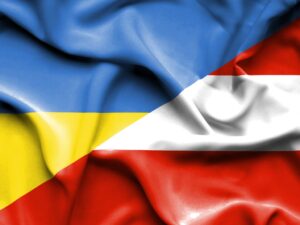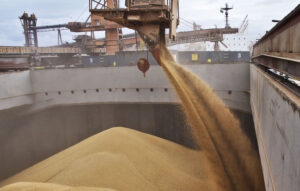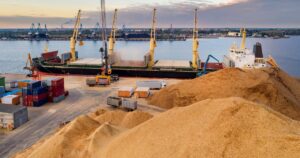
The National Association Ukrtsukor has asked the Cabinet of Ministers to urgently establish a zero quota on sugar exports to the European Union for 2024 due to the achievement of the maximum volume stipulated by the EU decision for the export of Ukrainian sugar to these countries in 2024, the association reported on Facebook.
“In fact, we are talking about initiating the closure of Ukraine’s border for sugar exports to the EU as soon as possible due to the fact that sugar exports have already reached 262.6 thousand tons, defined as Ukraine’s quota for 2024,” the statement said.
“Ukrtsukor believes that such an appeal is a confirmation of the constructive position of Ukrainian sugar producers and their readiness to integrate into the European sugar market and meet its requirements.
The business association reminded that on May 13, 2024, the Council of the European Union approved the extension of temporary trade liberalization measures for Ukraine for another year, until June 5, 2025. At the same time, it provided for the application of an emergency braking mechanism for particularly sensitive agricultural products, in particular sugar, if imports of these products in 2024 exceed the average imports recorded in the second half of 2021 and throughout 2022 and 2023. Similar emergency braking measures may be applied in 2025 if, in the period from January 1, 2025 to June 5, 2025, the volume of Ukrainian exports exceeds 5/12 of the quota set for 2024.

From mid-May, the Austrian Ministry of Finance and the Austrian export credit agency OeKB (Oesterreichische Kontrollbank Aktiengesellschaft) will start accepting applications for export and investment insurance in Ukraine at the expense of a special fund for Ukraine created by the Ministry of Finance in OeKB through the budget law.
According to the Austrian agency’s press release, it is expected that EUR500 million will be allocated to cover operations in Ukraine over the next five years, and the attraction of funds from international financial institutions could make it possible to receive up to EUR1 billion.
“Approximately EUR100 million per year is earmarked for new business. This will also open up opportunities for Austrian exporters in the process of Ukraine’s recovery,” the Ministry of Finance said in a release.
It is indicated that as part of the existing and proven export promotion procedure, the Ministry of Finance is already facilitating export transactions worth EUR 3-5 million in Ukraine with payment terms of up to three years through OeKB.
It is noted that since funds are limited and the goal is to achieve a wide diversification of risks, in particular in the supported sectors, small and medium-sized public sector transactions based on a state guarantee will be possible at the first stage.
“This will allow us to make vital investments for Ukraine. These include the supply of drinking water and heat, the provision and rehabilitation of the transport sector with roads, bridges and rail infrastructure, as well as supply agreements and investments such as joint repair shops for buses, trams and trains,” commented Finance Minister Magnus Brunner.

In the first nine months of the 2023-2024 marketing year (MY), Kernel Agro Holding exported 1 million tons of sunflower oil in bulk to almost 30 countries, the company’s press service reported on Facebook.
“We remain the largest agricultural exporter of sunflower oil and are among the TOP-3 total exports of Ukraine,” the statement said.
According to the agroholding, about 50% of the total volume of sunflower oil was supplied to India, 8% to the UAE, 7% to China and Spain, 5% to Italy, and 2% to Iraq, Singapore, Switzerland, Turkey, and Hong Kong.
“To expand the export opportunities of the entire industry, last year we started offering our infrastructure capacities to other agricultural producers in the market. At the company’s terminals in Odesa region, we provide transshipment services for grain crops and vegetable oil,” Kernel said.
In addition, the agricultural holding is completing the construction of one of the largest oil extraction plants in Europe in Starokonstantinov, Khmelnytsky region. Its processing capacity will be 1 million tons of seeds per year.
“This will allow us to increase the export of vegetable oil, a value-added product, and support agricultural producers in the region by providing them with opportunities to sell their products,” the agricultural holding explained.
As reported, Kernel processed 816 thsd tonnes of sunflower seeds in the third quarter of fiscal year (FY) 2024, up 10% year-on-year.
At the same time, sales of sunflower oil in January-March 2024 increased by 44% year-on-year to 394 thsd tonnes, totaling 1,103 thsd tonnes in the first nine months of 2024.
Before the war, Kernel Agro Holding was the world’s leading producer of sunflower oil (approximately 7% of global production) and its exports (approximately 12%). It is one of the largest producers and sellers of bottled oil in Ukraine. In addition, it is engaged in the cultivation and sale of agricultural products.
Kernel’s net profit for FY2023 amounted to $299 million, while the company ended the previous year with a net loss of $41 million. The agricultural holding’s revenue for FY2023 decreased by 35% to $3.455 billion, but EBITDA increased 2.5 times to $544 million.
In the first half of FY2024, Kernel’s net profit fell 3.6 times compared to the first half of FY2023, to $102 million, and EBITDA halved to $223 million, with revenue down 16% to $1.59 billion.

The head of the Odessa regional military administration Oleg Kiper in August 2023 by his order strengthened customs control in the region when exporting agricultural products for export, at the same time on the market of export of agricultural products appeared about 40 companies with signs of fictitiousness, reported hromadske in the investigation “Grain Baron”.
The publication noted that through the ports of Odessa in 2023 passed 85 percent of the country’s agro-exports.
When analyzing the data of the Ukrainian customs, access to which is provided by the international service ImportGenius, journalists found 40 companies with signs of fictitiousness, which entered the agro export market after the Odessa OSA established “manual control” over it.
These companies started exporting grain after August 2023. They have never engaged in exports before, were founded or changed owners in 2023, are not part of well-known agroholdings and do not own land.
“The largest by export volume of these firms has the same phone number as another 139 legal entities. And in second place is a company whose founder is probably a psychologist from Uzbekistan, for whom 20 legal entities have been registered in Ukraine over the past two years,” the investigation said.
“Suspicious” companies for the last quarter of 2023 exported through the ports of the Odessa region about 800 thousand tons of agricultural products worth about $ 150 million, or 6 billion UAH, says the publication and recalls that the head of the Odessa Regional State Administration explained the establishment of manual control by the need to fight against one-day companies and so-called “black exports”.
Such one-day companies export grain and do not return foreign currency proceeds to the country, do not pay taxes, have a fake director and do not have an office. After several transactions with a budget of several million dollars, the company disappears.
The chairman of the All-Ukrainian Agrarian Union “Agrarnaya Rada” Dmytro Kohan drew attention to the fact that any manual control has increased risks of corruption.
The Odessa regional military administration refused to comment on the facts revealed by journalists.

The flow of grain ships through the ports of Odessa Region is bringing long-awaited support to Ukraine’s economy. However, analysts warn that this may be a temporary phenomenon.
“In early March in Odessa, a 700-foot Liberian-flagged vessel slowly sailed out of the port, passing rows of yellow cranes and plunging into the calm waters of the Black Sea. Its hull was almost completely submerged as the ship was loaded with corn bound for Bangladesh. Meanwhile, other ships laden with grain have already left port, bypassing those that were just arriving,” the New York Times reported.
What seemed impossible last summer, when the Russian naval blockade paralyzed all commercial activity, is now a reality. The port was back on track thanks to a military campaign that drove Russian warships out of Ukrainian waters and provided a trade route for supplies to foreign markets.
Ukrainian grain and oilseed exports across the sea, which are vital to the Ukrainian economy, have almost returned to prewar levels, according to data provided to the New York Times. Over the past six months, Ukraine exported 27.6 million tons of grain and oilseeds across the Black Sea, only 0.2 million tons less than the average volume for the same period from 2018 to 2021 before Russia’s invasion in February 2022.
In the first quarter of this year, Black Sea exports even exceeded pre-war figures, according to Ukrainian data.
Grain and oilseed export estimates from Dragon Capital, a Kiev-based investment firm, and data from Lloyd’s List Intelligence, a shipping analytics firm, confirm this trend.
Sal Gilberti, head of Teucrium Trading, a U.S. company that trades agricultural commodities on the New York Stock Exchange, said claims by Ukrainian officials that grain exports across the sea are close to prewar levels are “accurate.”
Ukraine still faces challenges that could prevent grain exports from stabilizing at previous levels, including continued Russian attacks on port infrastructure and a reduced harvest this year. The U.S. Department of Agriculture predicts a decline in grain exports in the near future.
However, analysts say the overall environment is improving and freight companies are willing to transport Ukrainian grain despite the war. “The data shows there is no shortage of shipowners willing to take the risk and go for it,” said Greg Miller, senior maritime journalist at Lloyd’s List.
Maintaining high levels of grain exports is a strategic necessity for Ukraine. Grain and oilseeds accounted for a third of Ukrainian exports last year, said Natalia Spygotska, senior analyst at Dragon Capital. It has become critical to sustaining Ukraine’s economy and ultimately its war effort.
Tariel Khajishvili, head of Novik LLC, a Ukrainian ship agent operating in Odessa, said: “It is obvious that without grain exports, the country’s economy will collapse.”
After the invasion, Russia seized control of the Black Sea, blocking trade for months, jeopardizing global food security. In July 2022, a deal brokered by the UN and Turkey allowed Ukraine to resume exports through an agreed corridor in the Black Sea.
But a year later, Russia pulled out of the agreement and threatened all commercial ships traveling to or from Ukraine, leading to a complete halt to maritime grain exports last August.
To resume exports, the Ukrainian army launched a campaign to drive the Russian navy out of part of the Black Sea, destroying many warships and attacking their headquarters in Russia-occupied Crimea. The successful operation allowed Ukraine to create a new trade corridor along the coast that allows ships to enter the territorial waters of NATO countries.
Dmytro Barinov, deputy head of the Ukrainian Sea Ports Administration, recalls how nervous they were when the first grain ship passed through the corridor in mid-September: “We prayed that everything would go well.
Eventually, the ship successfully sailed into the open sea, and soon the “familiar pleasant sounds” of the ship’s sirens were again heard in Odessa.
The number of grain ships arriving at the three ports of the Odessa region – Odessa, Pivdennyi and Chernomorsk – increased to 231 in March from just 5 in September, according to Lloyd’s List.
Ukraine’s ship insurance arrangements with global insurers also contributed to the increase. Mr. Gilberti of Teucrium Trading added that Moscow is also interested in keeping the fighting out of the Black Sea, as it is also used to export Russian goods.
Today, Ukraine can only use ports in the Odessa region for grain exports, as other seaports are either too close to Russian positions or occupied by Russian troops. Despite this, with 4.1 million tons of grain and oilseeds shipped monthly, these three ports are close to pre-war export volumes.
The opening of the Odessa ports brought welcome financial relief to Ukraine. Having lost key economic assets during the war, such as steel mills in the east seized or destroyed by Russia, Ukraine is now more dependent on grain exports to support the economy. Dragon Capital predicted in the fall that a return to full operation of Odessa ports could add several percentage points to Ukraine’s GDP growth this year, which was forecast at 4 percent.
However, analysts warn that the initial success of Ukraine’s new trade route may be short-lived.
Russia continues to strike port infrastructure in Odessa, and with Ukraine’s air defenses in short supply, more missiles are reaching their target. In mid-April, Russia successfully struck two terminals in Pivdenne, destroying several containers.
Dragon Capital’s Ms. Spygotska also noted that high volumes of recent grain exports partly reflect shipments delayed by the Russian blockade, which could make it difficult to achieve those volumes in the future, especially with grain production projected to decline.
“Producers and exporters are now well positioned to export all available crops,” she said. “But it all depends on the harvest.”